Lesson Note on Mathematics
Modular Arithmetics
week 3-5
Theme: Modular Arithmetics
Topic: congruence and Residues of Modular
Sub Topic: Operation with Modula Arithmetic (Residues)
Date: dd/mm/yyyy
Class: S.S.S 1
Duration: 30 Minutes
No of Learners: 30
Learning Objectives:
By the end of the lesson learners should be able to:Defined Modular arithmetic.
Is defined as the arithmatic of remainder where an integer is divided by a fixed non-zero integer. Moduli is the plural of modulus.
In general, in modular arithmetic, you do arithmetic with the numbers from 1 to n as normal, and if your answer goes outside that range you add or subtract multiples of n to get back into the range.
The number n is called the modulus, and the calculations are said to be done modulo n or mod n.
Instead of the usual equality sign (=), the symbol ≡ is used in modular arithmetic.
E.g
b ≡ r(mod k)
2 ≡ 7(mod 5)
6 ≡ 13(mod 7)Defined the congruent and residue of modular.
Two integers are congruent to each other concerning a module if their difference is a multiple of the modulus.
Or
If two integers b and r have the property that b-r is divided by k, then b and r are called congruent modulo k while r is called the residue written as
b ≡ r(mod k)
NOTE; 0, 1, 2, 3, 4, --- k-1 is the set of residues mod k.
i.e, in mod 6, the largest residue is 5
in mod 10, the largest residue is 9
in mod y, and the largest residue is y-1
Examples-
2 ≡ 7(mod 5)
2-7 = -5
-5÷5 = -1
Hence; 2 ≡ 7(mod 5) is a congruence of mod 5 -
6 ≡ 13(mod 7)
6-13 = -7
-7÷7 = -1
Hence; 6 ≡ 13(mod 7) is a congruence of mod 7 -
25 ≡ 11(mod 7)
25-11 = 14
14÷7 = 2
Hence; 25 ≡ 11(mod 7) is a congruence of mod 7 -
13 ≡ 1(mod 12)
13-1 = 12
12÷12 = 1
Hence; 13 ≡ 1(mod 12) is a congruence of mod 12 -
15 ≡ 0(mod 15)
15-0 = 15
15÷15 = 1
Hence; 15 ≡ 0(mod 15) is a congruence of mod 15 -
5 ≡ -5(mod 5)
5-(-5) = 10
10÷5 = 2
Hence; 5 ≡ -5(mod 1) is a congruence of mod 5 -
-3 ≡ 11(mod 4)
-3-11 = -8
-8÷4 = -2
Hence; -3 ≡ 11(mod 4) is a congruence of mod 4 -
-3 ≡ 7(mod 4)
-3-7 = -10
-10÷4 = 2.5
Hence; -3 ≡ 7(mod 4) is NOT a congruence of mod 4
-
2 ≡ 7(mod 5)
explain and compute a residue that is equivalent to a given residue.
When two residue leaves the same remainder upon division by the modulus, the such residue is said to be equivalent residue.
i.e Whenever two residues x and y are found to be equivalent relative to a fixed modulus k, we write; that ifx ≡ y(mod k) then,
y ≡ x(mod k)
where nk ≡ 0
where n is an integer
Example
- Show that 5 and 2 are equivalent in mod 3.
Solution
5 ≡ 1x3+2(mod 3) ----- the residue is = 2
2 ≡ 0x3+2(mod 3) ----- the residue is =2
Hence 5 and 2 are equivalent in mod 3. - Find the positive integer of the least absolute value that is equivalent to 33 in mod 7.
Solution
33 ≡ 4x7+5(mod 7)
5 ≡ 0x7+5(mod 7)
Therefore 33 ≡ 5 (mod 7)
Hence, the integer is 5 - Find the smallest integer than 0 that is equivalent to
- 34 in mod 5
- 6 in mod 9
- 130 in mod 12
Solution
- 34 ≡ 6x5+4(mod 5)
4 ≡ 0x5+4(mod 5)
Therefore 34 ≡ 4 (mod 5) - 6 => 6+9 = 15 (you can add multiple modular to an integer if the integer is less than the modular)
Therefore, 15 ≡ 1x9+6(mod 9)
6 ≡ 0x9+6(mod 9)
Therefore 15 ≡ 6(mod 9) - 130 ≡ 10x12+10(mod 12)
10 ≡ 0x12+10(mod 12)
Therefore 130 ≡ 10(mod 12)
- Show that 5 and 2 are equivalent in mod 3.
carry out basic operations (addition, subtraction, multiplication and division) of residue
ADDITION IN MODULAR
Mod 7 Addition Table
0 1 2 3 4 5 6 0 0 1 2 3 4 5 6 1 1 2 3 4 5 6 0 2 2 3 4 5 6 0 1 3 3 4 5 6 0 1 2 4 4 5 6 0 1 2 3 The symbol show addition in modular arithmetic. This shows that it is different from ordinary arithmetic.
In the table, multiples of 4 are ignored and remainders are written.- Evaluate 5 6 in mod 8
Solution
5 6 = 11
Therefore, 11 ≡ 1x8+3(mod 8)
11 ≡ 3(mod 8)
Therefore 5 6 ≡ 3(mod 8) - Simplify 1. 12 7 and 2. 13 9 given that all the residues are in mod 5.
Solution
- 12 7 in mod 5
12 7 = 19
19 ≡ 3x5+4(mod 5)
19 ≡ 4(mod 5)
Therefore 12 7 ≡ 4(mod 5)
ALTERNATIVELY
12 7 in mod 5
12 in mod 5 is 12 ≡ 2x5x2(mod 5)
7 in mod 5 is 7 ≡ 1x5+2(mod 5)
Therefore
12 ≡ 2(mod 5)
7 ≡ 2(mod 5)
Hence, 12 7 in mod 5
12 7(mod 5) ≡ 2 2(mod 5)
12 7(mod 5) ≡ 4(mod 5) - 13 9(mod 5)
Solution
13 9 = 22
22 ≡ 4x5+2(mod 5)
22 ≡ 2(mod 5)
Therefore, 13 9(mod 5) ≡ 2(mod 5)
- 12 7 in mod 5
- Evaluate 5 6 in mod 8
SUBTRACTION IN MODULAR
Mod 6 Subtraction Table
0 1 2 3 4 5 0 0 5 4 3 2 1 1 1 0 5 4 3 2 2 2 1 0 5 4 3 3 3 2 1 0 5 4 4 4 3 2 1 0 5 5 5 4 3 2 1 0 The symbol show subtraction in modular arithmetic. This shows that it is different from ordinary arithmetic.
In the table, multiples of 4 are ignored and remainders are written.
NOTE: 2 1 ≠ 1 2
- Evaluate 8 3 (mod 6)
SOLUTION
8 3 (mod 6) ≡ 5(mod 6)
ALTERNATIVELY
8 3 (mod 6)
8(mod 6) ≡ 1x6+2(mod 6)
8(mod 6) ≡ 2(mod 6)
3(mod 6) => 3 6(mod 6)
9(mod 6) ≡ 1x6+3(mod 6)
:. 3(mod 6) ≡ 3(mod 6)
Hence, 8 3 (mod 6) ≡ 2(mod 6) 3 (mod 6)
8 3 (mod 6) ≡ 2 3 (mod 6)
8 3 (mod 6) ≡ -1(mod 6)
-1(mod 6) => -1 6(mod 6)
-1(mod 6) => 5(mod 6)
Hence, 8 3 (mod 6) ≡ 5(mod 6) - Simplify 23 2 in mod 7
SOLUTION
23 2 (mod 7) => 21(mod 7)
21(mod 7) ≡ 3x7+0(mod 7)
21(mod 7) ≡ 0(mod 7)
:. 23 2 (mod 7) ≡ 0(mod 7)
ALTERNATIVELY
23 2 (mod 7)
23(mod 7) ≡ 3x7+2(mod 7)
23(mod 7) ≡ 2(mod 7)
2(mod 7) ≡ 2(mod 7)
:. 23 2 (mod 7) ≡ 2(mod 7) 2 (mod 7)
23 2 (mod 7) ≡ 2 2 (mod 7)
23 2 (mod 7) ≡ 0(mod 7) - Find the the inverse, concerning addition, of the following residues.
- -5(mod 5)
- 5(mod 10)
- -7(mod 8)
- 3(mod 13)
SOLUTION- -5(mod 5)
the inverse of -5 is 5
5(mod 5) ≡ 0(mod 5) - 5(mod 10)
the inverse of 5 is -5
-5 10(mod 10) ≡ 5(mod 10)
:. 5(mod 10) ≡ 5(mod 10) - -7(mod 8)
the inverse of -7 is 7
7(mod 8) ≡ 7 (mod 8) - 3(mod 13)
the inverse of 3 is -3
-3(mod 13) ≡ 3 13(mod 13)
-3(mod 13) ≡ 10(mod 13)
- Evaluate 8 3 (mod 6)
MULTIPLICATION IN MODULAR
Mod 7 Multiplication Table
0 1 2 3 4 5 6 0 0 0 0 0 0 0 0 1 0 1 2 3 4 5 6 2 0 2 4 6 1 3 5 3 0 3 6 2 5 1 4 4 0 4 1 5 2 6 3 5 0 5 3 1 6 4 2 6 0 6 5 4 3 2 1 The symbol show multiplication in modular arithmetic. This shows that it is different from ordinary arithmetic.
In the table, multiples of 4 are ignored and remainders are written.
- Evaluate
- 5 6in mod 10
SOLUTION
5 6in mod 10
30 in mod 10
30 ≡ 5x6+0 (mod 10)
30 ≡ 0 (mod 10)
:. 5 6≡ 0 (mod 10) - 5 6in mod 14
SOLUTION
30 in mod 14
30 ≡ 2x14+2 (mod 14)
30 ≡ 2 (mod 14)
:. 5 6≡ 2 (mod 14) - 7 1 9 in mod 3
SOLUTION
7 1 9 in mod 3
133 in mod 3
133 ≡ 44x3+1 (mod 3)
133 ≡ 1 (mod 3)
:. 7 1 9 ≡ 1 (mod 3)
ALTERNATIVELY
7 1 9 in mod 3
7 ≡ 2x3+1 (mod 3)
19 ≡ 6x3+1 (mod 3)
:. 7x19 ≡ 1x1 (mod 3)
7x19 ≡ 1 (mod 3)
- 5 6in mod 10
DIVISION IN MODULAR
The modular division is trickier. We start with the idea that division is supposed o be the opposite of multiplication. The concept of multiplication inverse of the denomination is used in modular division.
m n ≡ m n -1Mod 7 Division Table
0 1 2 3 4 5 6 0 NA 0 0 0 0 0 0 1 NA 1 4 5 2 3 6 2 NA 2 1 3 4 6 5 3 NA 3 5 1 6 2 4 4 NA 4 2 6 1 5 3 5 NA 5 6 4 3 1 2 6 NA 6 3 2 5 4 1 The symbol show division in modular arithmetic. This shows that it is different from ordinary arithmetic.
Division in modular arithmetic may give more than one value or even no value at all.
If we can find two residues say m and n in mod k such that;
m n≡ 1 (mod k)
Then, n ≡ m-1 (RECAL: from indices) if n = m-1
then n = 1/m
and n x m = 1
HENCE, n ≡ m-1
We refer to n as the multiplicative the inverse of m in mod k. Therefore, if m is the multiplicative the inverse of n then n is also the multiplicative the inverse of m in the same modulus.
:. n m ≡ n m-1
In the mod 7 multiplication table above, the multiplication the inverse of the residues is obtained from the table.
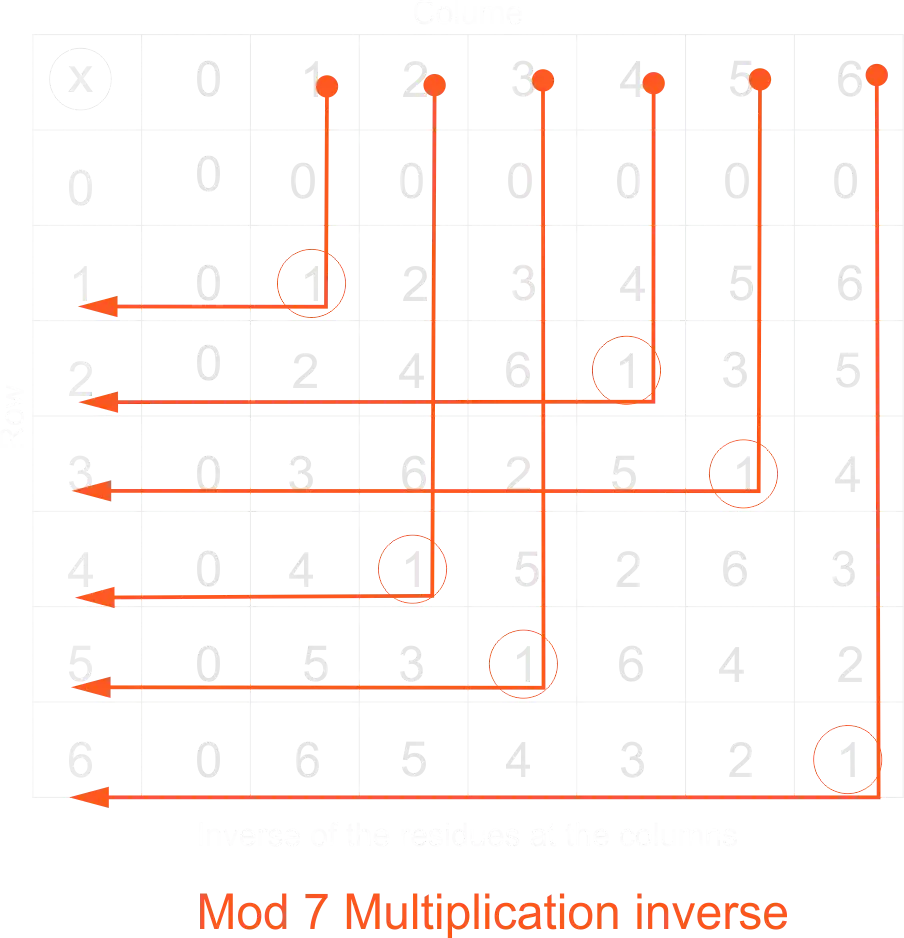
- 1-1 ≡ 1
- 2-1 ≡ 4 hence 4-1 ≡ 2
- 3-1 ≡ 5 hence 5-1 ≡ 3
- 4-1 ≡ 2 hence 2-1 ≡ 4
- 5-1 ≡ 3 hence 3-1 ≡ 5
- 6-1 ≡ 6
- 0 has no the inverse
- Evaluate 4 3 in mod 7
SOLUTION
4 3 ≡ 4 3 -1
But 3-1 ≡ 5 (mod 7) "from the mod 7 multiplication table"
:. 4 3 -1 ≡ 4 5 ≡ 20
:. 4 3 (mod 7) ≡ 2x7+6 (mod 7)
4 3 (mod 7) ≡ 6 (mod 7) - Evaluate 4 3 in mod 5
SOLUTION
4 3 ≡ 4 3 -1
But 3-1 ≡ 2 (mod 5) "from the mod 5 multiplication table"
:. 4 3 -1 ≡ 4 2 ≡ 8
:. 4 3 (mod 5) ≡ 1x5+3 (mod 7)
4 3 (mod 5) ≡ 3 (mod 5) - Evaluate 9 5 in mod 7
SOLUTION

9 5 ≡ 9 5 -1
But 5-1 ≡ 3 (mod 7) "from the mod 7 multiplication table"
:. 9 5 -1 ≡ 9 3 ≡ 27
:. 9 5 (mod 7) ≡ 3x7+6 (mod 7)
9 5 (mod 7) ≡ 6 (mod 7) - Evaluate 6 2 in mod 8
SOLUTION
6 2 ≡ 6 2 -1
But 2-1 in mod 8 does not exist "from the mod 8 multiplication table"
Hence,
6 2 (mod 8) has no solution.
solve modular arithmetics with more than one operation.
EXAMPLES- Simplify 7 5 in mod 4
SOLUTION
7 5 (mod 4)
Applying BODMAS
2 5 7 (mod 4)
7 7 (mod 4)
≡ 0 (mod 4) - Simplify 2 5 4 (mod 7)
SOLUTION
3 2 5 4 (mod 7) ≡ (3 2) (5 4)
3 2 5 4 (mod 7) ≡ 6 (5 4-1)
But 4-1≡ 2 (mod 7)
:. 3 2 5 4 (mod 7) ≡ 6 (5 2)
3 2 5 4 (mod 7) ≡ 6 10
3 2 5 4 (mod 7) ≡ -4
3 2 5 4 (mod 7) ≡ -4 7 (mod 7)
:. 3 2 5 4 (mod 7) ≡ 3 (mod 7) - Simplify (3 7 1) 5 (mod 9)
SOLUTION
(3 7 1) 5 (mod 9)
(3 7 1) 5-1 (mod 9)
(21 1) 5-1 (mod 9)
But 5-1 ≡ 2 (mod 9) that is; from the mod 9 multiplication table
:. (21 1) 5-1 (mod 9) ≡ 22 2 (mod 9)
44 (mod 9) ≡ 4 9 8 (mod 9)
:. (3 7 1) 5 (mod 9) ≡ 8 (mod 9)
- Simplify 7 5 in mod 4
Rationale:
Modular arithmetic, also known as clock arithmetic, every time you tell the time, you are dealing with the modulus 12. There exist several events, conditions or quantities that usually vary in a sequence such that, whenever a certain fixed amount is attained, the sequence is repeated. Most of these events or conditions are related to time, such as- 1 rotation of the hour hand of the clock or records 12 hrs (half day).
- 1 rotation of the minute hand of the clock or watch records 60 mins or 1 hr.
- 1 rotation of the second hand of the clock or watch records 60 secs or 1 minute.
- 1 rotation of 7 days records 1 week
- 1 rotation of 24 hours record 1 day
- Except for the leap year, 1 rotation of 365 days records 1 year
- 1 rotation of 12 months record 1 year
Prerequisite/ Previous knowledge:
The learners have learnt about the time.Learning Materials:
Clock, calender, textbooks.Reference Materials:
- Man Mathematics for Senior Secondary Schools 1
- New General Mathematics Textbook for West Africa
- OnlineResources
Lesson Development:
| STAGE | TEACHER'S ACTIVITY | LEARNER'S ACTIVITY | LEARNING POINTS | ||||||||||||||||||||||||||||||||||||||||||||||||||||||||||||||||||||||||||||||||||||||||||||||||||||||||||||||||||||||||||||||
|---|---|---|---|---|---|---|---|---|---|---|---|---|---|---|---|---|---|---|---|---|---|---|---|---|---|---|---|---|---|---|---|---|---|---|---|---|---|---|---|---|---|---|---|---|---|---|---|---|---|---|---|---|---|---|---|---|---|---|---|---|---|---|---|---|---|---|---|---|---|---|---|---|---|---|---|---|---|---|---|---|---|---|---|---|---|---|---|---|---|---|---|---|---|---|---|---|---|---|---|---|---|---|---|---|---|---|---|---|---|---|---|---|---|---|---|---|---|---|---|---|---|---|---|---|---|---|---|---|---|
| INTRODUCTION full class session (10 mins) |
Asking some questions:
|
Learners' expected response.
|
Learner’s entry points. Competences: Critical thinking, Communication. |
||||||||||||||||||||||||||||||||||||||||||||||||||||||||||||||||||||||||||||||||||||||||||||||||||||||||||||||||||||||||||||||
|
|
|||||||||||||||||||||||||||||||||||||||||||||||||||||||||||||||||||||||||||||||||||||||||||||||||||||||||||||||||||||||||||||||||
| STEP 1 5 mins. Development |
Ask students to form three groups. | Form three groups and share responsibility. | Inculcating leadership skills, competitive spirit, cooperation, teamwork and a sense of responsibility among learners. | ||||||||||||||||||||||||||||||||||||||||||||||||||||||||||||||||||||||||||||||||||||||||||||||||||||||||||||||||||||||||||||||
| Teacher to provide learners with materials (Wall clock, calendar) and instructions and allow them to identify the materials The teacher thereafter asks learners.
The teacher explains the concept of modular to students and thereafter guild the students to define modular.
|
Students take materials needed for this activity and identify the materials as a Wall clock, and calender. Hence respond to the teacher's questions
The students define modular; Modular is an arithmetic of remainder where an integer is divided by a fixed non-zero integer. |
Developing the concept of modular arithmetic | |||||||||||||||||||||||||||||||||||||||||||||||||||||||||||||||||||||||||||||||||||||||||||||||||||||||||||||||||||||||||||||||
| Step 2 3 mins |
The teacher asks learners to calculate with the aid of the calendar. If today is Friday, what day of the week will it be in 19 days? The teacher explains the day it will be using modular if today is Friday. If 0 day ≡ Sunday then Friday ≡ 5 The day of the week 19 days after is 5 19 ≡ 24 (mod 7) 'i.e days of the week is a rotation of 7' 24 ≡ 3 7 3 :. 24 ≡ 3 (mod 7) :. The next day is 3 days after Sunday Hence; The expected day is Wednesday. |
Learners expected respond
HINTS: Sun (0), Mon (1), Tue (2), Wed (3), Thurs (4), Fri (5), Sat (6) Students counted 19 days from Friday and stopped on the 24th of Wednesday. Hence; The expected day is Wednesday. |
|||||||||||||||||||||||||||||||||||||||||||||||||||||||||||||||||||||||||||||||||||||||||||||||||||||||||||||||||||||||||||||||
| STEP 3 congruent and residue of modular (5 mins) |
The teacher explains the congruent and residue of modular, thus; If two integers b and r have the property that b-r is divided by k, then b and r are called congruent modulo k while r is called the residue written as b ≡ r(mod k) NOTE; 0, 1, 2, 3, 4, --- k-1 is the set of residues mod k. i.e, in mod 6, the largest residue is 5 in mod 10, the largest residue is 9 in mod y, and the largest residue is y-1 Example 13 ≡ 1(mod 12) 13-1 = 12 12÷12 = 1 Hence; 13 ≡ 1(mod 12) is a congruence of mod 12 -3 ≡ 7(mod 4) -3-7 = -10 -10÷4 = 2.5 Hence; -3 ≡ 7(mod 4) is NOT a congruence of mod 4 The teacher asks students questions. Which of the following statement is true
|
Students pay attention and ask questions. Learners expected respond
|
Communication. congruent and residue of modular. |
||||||||||||||||||||||||||||||||||||||||||||||||||||||||||||||||||||||||||||||||||||||||||||||||||||||||||||||||||||||||||||||
| STEP 4 Equivalent residue of a modulus 5 mins |
Ask students,
The teacher explains equivalent residues to students, thus; Whenever two residue x and y are found to be equivalent relative to a fixed modulus k, we write; that if x ≡ y(mod k) then,
|
Students expected to respond.
Example
|
Collaboration among group members, manipulation of results and observing the equivalent residue. | ||||||||||||||||||||||||||||||||||||||||||||||||||||||||||||||||||||||||||||||||||||||||||||||||||||||||||||||||||||||||||||||
| Step 5 Basic operation (addition, subtraction, multiplication and division) of residue 10 mins |
The teacher guides learners on how to carry out the addition of residue.
|
Learners pay attention to the teacher and follow the teacher's explanation.
|
Addition, Subtraction, Multiplication and Division of Residue. | ||||||||||||||||||||||||||||||||||||||||||||||||||||||||||||||||||||||||||||||||||||||||||||||||||||||||||||||||||||||||||||||
The teacher guides learners on how to carry out subtraction of residue.
|
Learners pay attention to the teacher and follow the teacher's explanation.
|
||||||||||||||||||||||||||||||||||||||||||||||||||||||||||||||||||||||||||||||||||||||||||||||||||||||||||||||||||||||||||||||||
The teacher guides learners on how to carry out the multiplication of residue.
|
Learners pay attention to the teacher and follow the teacher's explanation.
|
||||||||||||||||||||||||||||||||||||||||||||||||||||||||||||||||||||||||||||||||||||||||||||||||||||||||||||||||||||||||||||||||
The teacher guides learners on how to carry out the division of residue.
|
Learners pay attention to the teacher and follow the teacher's explanation.
|
||||||||||||||||||||||||||||||||||||||||||||||||||||||||||||||||||||||||||||||||||||||||||||||||||||||||||||||||||||||||||||||||
| Step 6 Modular arithmetics with more than one operation |
The teacher explains and guides learners in the application of BODMAS to solve modular arithmetic with more than one arithmetics operation. |
|
solving modular arithmetics with more than one operation | ||||||||||||||||||||||||||||||||||||||||||||||||||||||||||||||||||||||||||||||||||||||||||||||||||||||||||||||||||||||||||||||
| CONCLUSION 2 mins |
Teachers wrap up the learners' observations, summarise the learned knowledge, and give more clarification on the learned content. |
Participate actively in summarizing the content. Making short notes. |
Listening skills, Writing skills. | ||||||||||||||||||||||||||||||||||||||||||||||||||||||||||||||||||||||||||||||||||||||||||||||||||||||||||||||||||||||||||||||
| Assessment/ Assignment: 5 mins |
The teachers give learners a take-home and engage students to work individually.
|
Do exercises. | Competences: Creativity. | ||||||||||||||||||||||||||||||||||||||||||||||||||||||||||||||||||||||||||||||||||||||||||||||||||||||||||||||||||||||||||||||